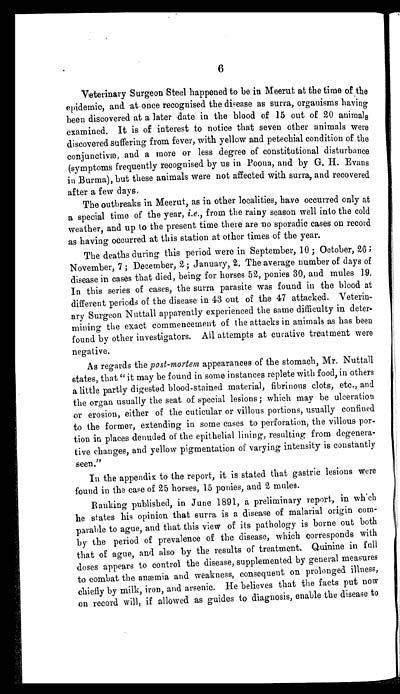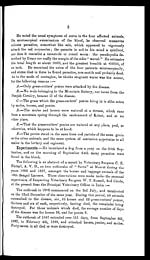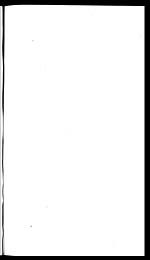Medicine - Veterinary > Civil Veterinary Departments > Civil Veterinary Department ledger series I-VI > Volume IV - Horse surra
(400) Page 6
Download files
Individual page:
Thumbnail gallery: Grid view | List view

6
Veterinary Surgeon Steel happened to be in Meerut at the time of the
epidemic, and at once recognised the disease as surra, organisms having
been discovered at a later date in the blood of 15 out of 20 animals
examined. It is of interest to notice that seven other animals were
discovered suffering from fever, with yellow and petechial condition of the
conjunctivæ, and a more or less degree of constitutional disturbance
(symptoms frequently recognised by us in Poona, and by G. H. Evans
in Burma), but these animals were not affected with surra, and recovered
after a few days.
The outbreaks in Meerut, as in other localities, have occurred only at
a special time of the year, i.e., from the rainy season well into the cold
weather, and up to the present time there are no sporadic cases on record
as having occurred at this station at other times of the year.
The deaths during this period were in September, 10; October, 26;
November, 7; December, 2; January, 2. The average number of days of
disease in cases that died, being for horses 52, ponies 30, and mules 19.
In this series of cases, the surra parasite was found in the blood at
different periods of the disease in 43 out of the 47 attacked. Veterin-
ary Surgeon Nuttall apparently experienced the same difficulty in deter-
mining the exact commencement of the attacks in animals as has been
found by other investigators. All attempts at curative treatment were
negative.
As regards the post-mortem appearances of the stomach, Mr. Nuttall
states, that "it may be found in some instances replete with food, in others
a little partly digested blood-stained material, fibrinous clots, etc., and
the organ usually the seat of special lesions; which may be ulceration
or erosion, either of the cuticular or villous portions, usually confined
to the former, extending in some cases to perforation, the villous por-
tion in places denuded of the epithelial lining, resulting from degenera-
tive changes, and yellow pigmentation of varying intensity is constantly
seen."
In the appendix to the report, it is stated that gastric lesions were
found in the case of 25 horses, 15 ponies, and 2 mules.
Ranking published, in June 1891, a preliminary report, in which
he states his opinion that surra is a disease of malarial origin com-
parable to ague, and that this view of its pathology is borne out both
by the period of prevalence of the disease, which corresponds with
that of ague, and also by the results of treatment. Quinine in full
doses appears to control the disease, supplemented by general measures
to combat the anæmia and weakness, consequent on prolonged illness,
chiefly by milk, iron, and arsenic. He believes that the facts put now
on record will, if allowed as guides to diagnosis, enable the disease to
Set display mode to: Large image | Zoom image | Transcription
Images and transcriptions on this page, including medium image downloads, may be used under the Creative Commons Attribution 4.0 International Licence unless otherwise stated. ![]()
| India Papers > Medicine - Veterinary > Civil Veterinary Departments > Civil Veterinary Department ledger series I-VI > Horse surra > (400) Page 6 |
|---|
| Permanent URL | https://digital.nls.uk/75517090 |
|---|




